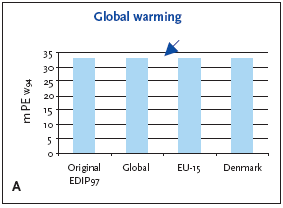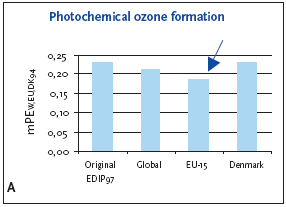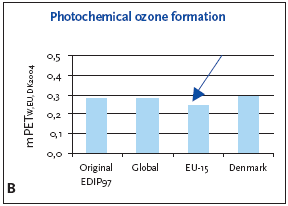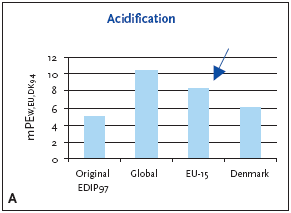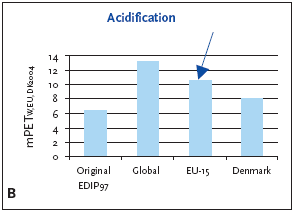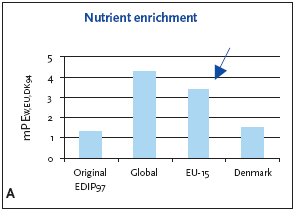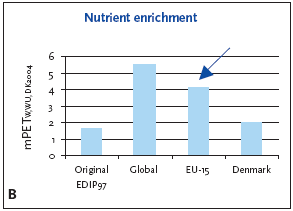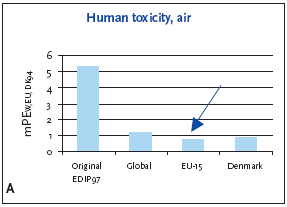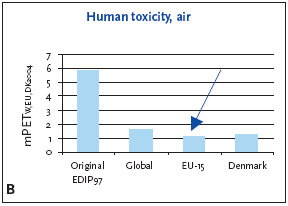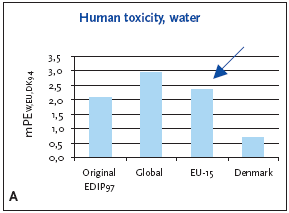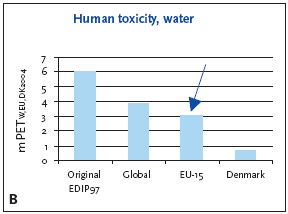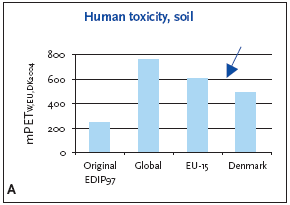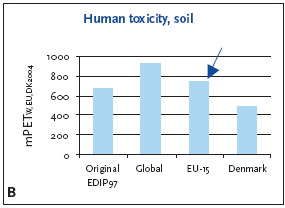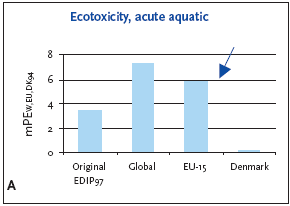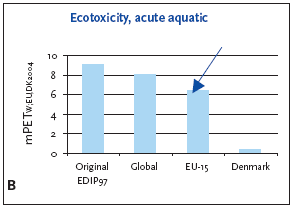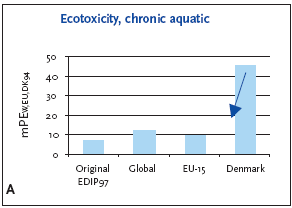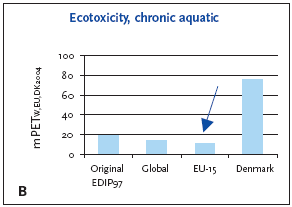|
Impact categories, normalisation and weighting in LCA 11. Example: Normalisation and weighting
This chapter presents an example on how to apply normalisation and weighting on the results of a life cycle impact assessment. Normalisation and weighting are performed on the results given as equivalent values, e.g. as GWP (global warming potential) measured in CO2-equivalents. The principles in normalisation and weighting are described in chapter 1, Introduction. Calculation of the normalised impact potential is done as follows:
where: Calculation of the weighted impact potential is done as follows:
where: The example is based on a case from the EDIP97 project (Mose et al., 1997), where the case including inventory data is presented in detail. The functional unit is defined as use of a refrigerator one year (the total lifetime is assumed to be 13 years). The original data are supplemented with arbitrary data for two impact categories to be able to illustrate the consequences of all the established normalisation references and weighting factors. The case presents production of a refrigerator in Denmark. This specific case is chosen as the impact assessment shows results for all the different impact categories except human toxicity via soil and chronic terrestrial ecotoxicity. The example is an old refrigerator containing CFC-11 as well as CFC-12; these ozone depleting substances have afterwards been substituted by other cooling agents. The results of the impact assessment expressed as impacts during the lifetime and per year are shown in Table 11.1. The actual locations of the impact potentials are not known. Obviously, the impacts from most upstream processes are located outside Denmark, while the impact potentials from the use and disposal stages primarily are located in Denmark. However, as the impact categories all contributes on the regional or global scale (no point sources for local impacts are identified in the study), it is chosen to normalise and weight the impact assessment results by using the appropriate EU-15 normalisation and weighting factors for all impact categories except global warming and stratospheric ozone depletion, where the global references are used. The different impact categories are presented and discussed one by one in the following sections. Applying a sensitivity analysis by using other normalisation references is discussed where found appropriate. Table 11.1 Environmental impact potentials related to production of a refrigerator (Mose et al., 1997).
1. These numbers are arbitrary and just used for illustrative purposes. The normalised and weighted impact potentials are shown in Table 11.2. The normalised as well as weighted impact potentials are calculated by using global and EU-15normalisation references and weighting factors, according to the general recommendations:
Table 11.2 Normalised and weighted impact potentials; the primary recommendation for impact potentials in Denmark is indicated by bold types. 11.1 Global warming11.1.1 Normalisation and weighting of global warming The normalisation references as well as the weighting factors are presented in Table 11.3. Table 11.3 Normalisation reference and weighting factors for global warming. Global warming
Global warming is a global effect and therefore a global normalisation reference is recommended.
where: Normalised GWP is the normalised global warming potential for the considered product GWP is the global warming potential for the considered product NormrefGWP is the normalisation reference for global warming Calculation of the weighted impact potential for the considered product is done as follows:
where: Weighted GWP is the weighted impact potential for global warming WFGWP is the weighting factor for global warming The normalisation reference has decreased slightly since 1990 resulting in higher normalised global warming potentials. Figure 11.1 also illustrates the weighted global warming potentials calculated by applying the global, EU-15 and Danish weighting factors. The weighted global warming potentials are decreasing in the above mentioned order. Stronger reduction targets globally than at EU-15 can explain this fact, i.e. Denmark and EU-15 are not far from the reduction target for 2004. 11.1.2 Results Figure 11.1 illustrates the normalised global warming potentials calculated by applying the global normalisation reference. Irrespective of where the impact potential is generated, the global normalisation reference combined with the global weighting factor for global warming are recommended. Based on an impact potential for the product in question at 0.29 ton CO2-eq./year the actual normalised and weighted values are 33 mPEW94 and 37 mPETW2004, respectively. Figure 11.1 Normalised (A) and weighted (B) global warming potentials for production of a refrigerator at different localities.
11.2 Stratospheric ozone depletion11.2.1 Normalisation and weighting of stratospheric ozone depletion Stratospheric ozone depletion is a global effect and therefore a global normalisation reference is recommended. The normalisation reference and weighting factor for stratospheric ozone depletion are presented in Table 11.4. The normalisation reference has been reduced by approximately 50% since 1990 leading to a 100% increase of the normalised ozone depletion potential. The reduction of the normalisation reference can be explained by the fast phase out of consumption of ozone depleting substances. Denmark has decided a total phase-out of ozone depleting substances before 2004, and the weighting factor is therefore "infinite" in principle. In the EU a similar plan is being discussed, but with the current targets the weighting factor can be calculated to 2.46. The global weighting factor has increased from 23 to 63, while the newly developed weighting factor for non-industralised countries is 4.4. Table 11.4 Normalisation reference and weighting factors for stratospheric ozone depletion.
11.2.2 Results Figure 11.2 illustrates the normalised ozone depletion potential calculated by applying the global normalisation reference. Irrespective of where the impact potential is generated, the global normalisation reference combined with the global weighting factor for ozone depletion is recommended. Based on an impact potential for the product in question at 0.046 kg CFC-11-eq./year the actual normalised and weighted values are 448 mPEW94 and 28230 mPETW2004, respectively. Figure 11.2 Normalised and weighted ozone depletion potentials for production of a refrigerator at different localities. 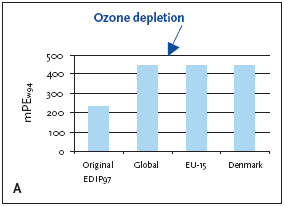 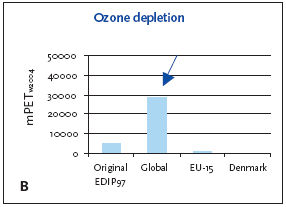
11.3 Photochemical ozone formation11.3.1 Normalisation and weighting of photochemical ozone formation For photochemical ozone formation as a regional effect the EU-15 normalisation reference is recommended for impact potentials located in Denmark as well as Europe or the global normalisation reference if the locality is outside Europe or unknown. The normalisation references and weighting factors for photochemical ozone formation are presented in Table 11.5. Table 11.5 Normalisation references and weighting factors for photochemical ozone formation.
The highest normalisation reference is calculated for EU-15 giving the lowest normalised potential for impact potentials located in Denmark or in Europe. If the impact potentials were located outside Europe or at an unknown location, the normalised impact potential would be slightly higher, about 10%, but this would to some extent be balanced by a lower weighting factor. 11.3.2 Results Figure 11.3 illustrates the normalised photochemical ozone formation potential. For impact potentials located in Denmark the EU-15 normalisation reference combined with the EU-15 weighting factor for photochemical ozone formation are recommended. Based on an impact potential for the product in question at 0.0046 kg C2H4-eq./year the actual normalised and weighted values are 0.18 mPEEU94 and 0.25 mPETEU2004 , respectively. The chosen normalisation reference puts less attention to photochemical ozone formation than if e.g. the global reference was applied. The difference is however small, about 10-15%, and the practical consequences are probably without importance. Figure 11.3 Normalised and weighted photochemical ozone formation potentials for production of a refrigerator at different localities.
11.4 Acidification11.4.1 Normalisation and weighting of acidification For acidification as a regional effect the EU-15 normalisation reference and weighting factor are recommended for impact potentials located in Denmark as well as Europe or the global normalisation reference if the locality is outside Europe or unknown. The normalisation references and weighting factors for acidification are presented in Table 11.6. Table 11.6 Normalisation references and weighting factors for acidification. Acidification
1 Weighting factors have not been established worldwide; the European weighting factors are recommended for impact potentials located outside Europe or at unknown locality The normalisation reference for Denmark has decreased with about 20% since 1990 resulting in an increase of the normalised acidification potential. The EU-15 normalisation reference is between the global and the Danish normalisation reference. 11.4.2 Results Figure 11.4 illustrates the normalised and weighted acidification potential. For impact potentials located in Denmark the EU-15 normalisation reference combined with the EU-15 weighting factor for acidification are recommended. Based on an impact potential for the product in question at 0.62 kg SO2-eq./year the actual normalised and weighted values are 8.3 mPEEU94 and 11 mPETEU2004, respectively. Figure 11.4 Normalised and weighted acidification potentials for production of a refrigerator at different localities.
As can be deduced from Table 11.6 and seen in Figure 11.4, the normalised result can vary with about 40%, depending on which normalisation reference is chosen. In the case of the refrigerator, acidification is more important using the European and global reference. This can be explained by the fact that the contribution from the average person is higher in Denmark than in the other regions, but the political weight on the issue is about the same. 11.5 Nutrient enrichment11.5.1 Normalisation and weighting of nutrient enrichment Nutrient enrichment is regarded as a local as well as a regional impact. The EU-15 normalisation reference is recommended for impact potentials located in Denmark and in Europe. For impact potentials located outside Denmark and Europe the global reference is recommended. The normalisation and weighting factors for nutrient enrichment are presented in Table 11.7. Table 11.7 Normalisation references and weighting factors for nutrient enrichment. Nutrient enrichment
1 Weighting factors have not been established worldwide; the European weighting factors are recommended for impact potentials located outside Europe or at unknown locality The Danish normalisation reference for nutrient enrichment has decreased slightly since 1990 giving an increase in the normalised potential. The EU-15 normalisation reference is less than half of the Danish reference probably due to significant differences in area distribution between land and water surface. Due to the applied extrapolation methodology the global reference is below the EU-15 reference giving a higher normalised nutrient enrichment potential for impact potentials located outside Europe or with unknown locality. 11.5.2 Results Figure 11.5 illustrates the normalised and weighted nutrient enrichment potential for the product. For a regional impact category like nutrient enrichment, the EU-15 normalisation reference and weighting factor are recommended. Based on an impact potential for the product in question 0.4 kg NO3-eq./year the actual normalised and weighted values are 3.4 mPEEU94 and 4.1 mPETEU2004, respectively. Figure 11.5 Normalised (A) and weighted (B) nutrient enrichment potentials for production of a refrigerator at different localities.
Table 11.7 and Figure 11.5 illustrate that the chosen normalisation reference and weighting factor (for EU-15) put more attention to nutrient enrichment than the Danish values, but on the other hand also put less attention to the issue than the global values. It is therefore recommended to examine whether the impact is important when compared to other impacts, using the Danish or global normalisation references. If so, a more detailed sensitivity analysis can be conducted, investigating the contribution from phosphorous and nitrogen compounds, and if possible, distinguishing between point sources and more general contributions. 11.6 Human toxicity11.6.1 Normalisation and weighting of human toxicity Human toxicity is considered as a local as well as a regional impact and the EU-15 normalisation reference and weighting factors are recommended for impact potentials located in both Denmark and Europe. If the location is unknown or outside Europe the global normalisation reference is recommended. The normalisation and weighting factors for human toxicity are presented in Table 11.8. Table 11.8 Normalisation references and weighting factors for human toxicity (exposure via air, water and soil).
1 Weighting factors have not been established world-wide; the EU weighting factors are recommended for impact potentials located outside Europe or at unknown locality. 2 Weighting factors have only been established for human toxicity via soil for Europe; the European weighting factor is recommended as default value for impact potentials located in Denmark. The Danish normalisation reference for human toxicity via air is lower than the EU-15 reference. The consequence is that normalising the toxicity potential with Denmark as reference results in a higher normalised potential than when using the EU-15 reference. For human toxicity via water and soil the highest normalisation reference is found for Danish conditions. The figures show the highest normalised potentials for impact potentials located outside Europe. 11.6.2 Results Figure 11.6 - Figure 11.8 illustrate the normalised and weighted human toxicity potentials. For a regional/local impact category like human toxicity, the EU-15 normalisation references and the EU-15 weighting factors are recommended. Based on impact potentials for human toxicity for the product in question the normalised and weighted impact potentials can be calculated for different media: via air: via water: Figure 11.6 Normalised (A) and weighted (B) human toxicity potentials, exposure by air for production of a refrigerator at different localities.
Figure 11.7 Normalised (A) and weighted (B) human toxicity potentials, exposure by water for production of a refrigerator at different localities.
Figure 11.8 Normalised (A) and weighted (B) human toxicity potential, exposure via soil for production of a refrigerator at different localities.
via soil: The figures illustrate that there is a large variation in the toxicity potentials, depending on the chosen normalisation reference. This finding calls for a more detailed sensitivity analysis examining the reason for the differences in more detail, e.g. by applying Danish normalisation references and weighting factors. Of special interest is to find a balance between toxicity to air and water, respectively, as the results in these categories point in opposite directions. It should be noticed that the significant decrease in normalised and weighted values is due to nmVOC from road transport being include in the new normalisation reference, but not in the calculation of the impact potential of the refrigerator. 11.7 EcotoxicityNormalisation and weighting of ecotoxicity Ecotoxicity is considered as a local (especially acute ecotoxicity to water) as well as a regional impact and the EU-15 normalisation reference and weighting factors are recommended for impact potentials located in both Denmark and Europe. If the location is unknown or outside Europe the global normalisation reference is recommended. The normalisation and weighting factors for ecotoxicity are presented in Table 11.9. Table 11.9 Normalisation references and weighting factors for ecotoxicity (acute aquatic, chronic aquatic and chronic terrestrial).
1 Weighting factors have not been established world-wide; the EU-15 weighting factors are recommended for impact potentials located outside Europe or at an unknown locality. For aquatic ecotoxicity the highest normalisation reference is found for Danish conditions. The figures show the highest normalised potentials for impact potentials located outside Europe. For terrestrial ecotoxicity the highest normalisation reference is found for Europe and the lowest reference for Denmark. 11.7.2 Results Figure 11.9 -Figure 11.10 illustrate the normalised and weighted aquatic ecotoxicity potentials and Figure 11.11 illustrates the normalised and weighted terrestrial ecotoxicity potentials. For impact potentials located in Denmark the EU-15 normalisation reference combined with the EU-15 weighting factor for ecotoxicity are recommended. With the given impact potentials for the product in question, the resulting normalised and weighted values are: acute aquatic chronic aquatic chronic terrestrial Figure 11.9 Normalised (A) and weighted (B) ecotoxicity potential, acute aquatic toxicity for production of a refrigerator at different localities.
Figure 11.10 Normalised (A) and weighted (B) ecotoxicity potential, chronic aquatic toxicity for production of a refrigerator at different localities.
Figure 11.11 Normalised (A) and weighted (B) ecotoxicity potential, chronic terrestrial toxicity for production of a refrigerator at different localities. 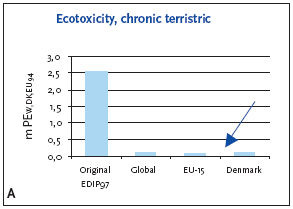 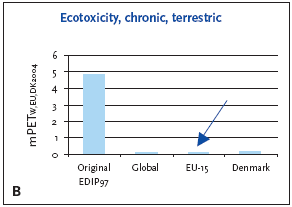
The figures show that the chosen normalisation reference (EU-15) puts more attention to acute and chronic toxicity than the Danish normalisation reference, but less than the global normalisation reference does. It is therefore of interest to identify the most important contributions to these impact categories and find out whether there are improvement options that are related to specific concerns on the relevant markets. In other words, the example shows that a sensitivity analysis using different normalisation references can provide additional insight into the examined product system. 11.8 General conclusionsThe primary purpose of the example is to show the LCA-practitioner the recommended choices of normalisation references and weighting factors in a specific case. At the same time, the example shows what the outcome would have been if other choices had been made. In this way the extended methodology can be seen as a binding element between the final steps in the impact assessment and important steps in the interpretation of the LCA, e.g. in the form of a sensitivity analysis. It is however stressed that it is not compulsory to neither use the extended possibilities, nor that it should be the first step in the interpretation. It is outside the scope of this report to discuss the findings in the example in detail, but it is obvious that the increased number of possibilities for choosing can provide a more balanced view of the life cycle impacts in the life cycle of a product. At the same time, however, the increased amount of information can also cause additional questions to be asked. Exactly which questions that will emerge cannot be determined at this moment, but it is a general recommendation that they should concentrate on those issues where significant changes are observed. In the specific case this would for example be to determine whether nutrient enrichment would be one of the important impact categories if the Danish or Global normalisation references were applied instead of the EU-15 reference. The first effort would be to look at the worst-case scenario for nutrient enrichment and compare the normalised/weighted result with that for the other impact categories. If the impact from nutrient enrichment is low in this comparison, the LCA- practitioner will know that it is a robust finding and that only little attention should be devoted to the impact category in the interpretation of the results. The improved possibilities for normalisation and weighting have not been utilised in "real" LCA so far. LCA-practitioners will most probably quickly find a way to use the possibilities, e.g. as a part of the sensitivity analysis. The efforts needed in doing so will decrease significantly when the first experiences have been gained.
|


